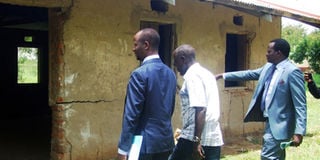Inde Technical Institute rots away despite government support

On the ground. MPs Ibrahim Semujju Nganda (left), Hassan Kaps Fungaroo (right) and Ogoko Sub-county councillor Hassan Manzu inspect one of the dilapidated classrooms at the institute last Friday. PHOTO BY FELIX W OKELLO.
What you need to know:
Dilapidated. Although the school received Shs100m for construction of new classroom blocks, only one block was constructed, housing only three classrooms and a small office.
Arua. The gate to the entry of Inde Technical Institute paints a sorrowful sight into the bushy institute, with dilapidated buildings and old cars parked in the school compound.
A walk around the school compound paints a grimmer picture as the oldest classroom block constructed during president Milton Obote II regime, has developed huge cracks on the walls. However, students are still using the dilapidated structure, though it is on the verge of collapsing.
The school, that used to admit about 250 students for various vocational courses, now has about 187 students, a worrying enrolment trend at the time when government is investing in vocational technical education.
Shades of big trees serve as classrooms. Sometimes, students forego classes, especially during the rainy seasons due to the coldness while studying under the trees.
The institute’s deputy principal, Mr Charles Andrua, said because of inadequate funds, they were forced to close the institute two weeks earlier than the scheduled time.
“We are still using this old structure that has developed cracks because we have inadequate classrooms. We don’t have modern equipment, computers or even power [electricity], yet these are important in training,” he said.
The school has no electricity because the authorities failed to extend power lines from the national grid at Ocoko Trading Centre, a distance of about 61kms, to the school.
He revealed that staff on government payroll have for the past five months not been paid. The school has 33 both teaching and non-teaching staff.
To address some of these challenges, Mr Andrua said they have an outreach programme where they take their students to Ragen Technical Institute in Arua Town to access some of the services they don’t provide at the institute. He said this has seen most of their students excel at national level exams.
In the 2014/2015 Financial Year, government gave the school Shs100m for construction of new classroom blocks. However, only one block was constructed, housing only three classrooms and a small office.
Mr Andrua also said the dwindling funds from government that has been cut from the initial Shs45m released per term to Shs29m, makes it difficult to impart skills to the youths.
The school relies on typewriters as there are no computers for secretarial work or computer lab for students and teachers.
The teachers do not want to stay at the institute because the area also lacks social and basic facilities.
There are no nearby shops where one can buy food and other household items. One has to travel about five kilometres to Rhino Camp Trading Centre to buy the items. This, according to some staff, demotivates one to teach or stay at the school.
During a tour to assess the status of the school and other government-aided institution in the region by MPs on the Parliamentary Committee on Government Assurance last Friday, the MPs, led by the Leader of Opposition in Parliament, Ms Winnie Kiiza, were shocked by the school’s status.
“Government needs to ensure that it provides modern equipment for this school and other technical institutions that are on the verge of collapse. This school should then be used as a model school to impart skills and knowledge to the youth. In this way, government can cut unemployment rate.”
The councillor for Ogoko Sub-county, Mr Hamza Manzu, said: “It is unfortunate that this school looks abandoned like there is no activity here. It doesn’t make sense for government to keep advocating for vocational schools yet this can be used as a model if it had all the necessary modern equipment for teaching the youth.”




